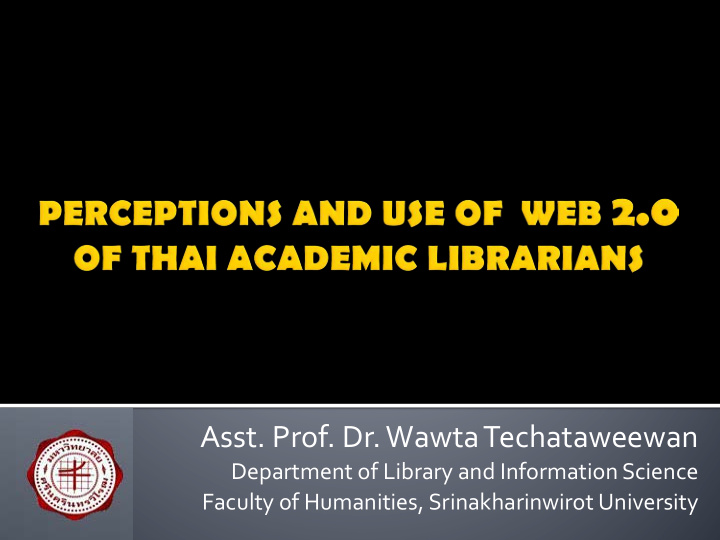



Asst. Prof. Dr. Wawta Techataweewan Department of Library and Information Science Faculty of Humanities, Srinakharinwirot University
QR code Ubiquitous technology Mobile technology Cloud computing Web 2.0, Web 3.0…
The second generation development and design of web to facilitate communication and secure information, sharing inter- operability and user-centered design.
Marketing To push information to users and public in up-to-date way To meet the various users, especially the youths, who those are on the Internet To guide the users to their appropriate information sources Managing the Internet information Monitoring what discussion about the library Employing any tasks with easy way Saving the budget
Blog / Weblog Library Wiki RSS (Really Simple Syndication) Podcast File sharing Tagging / Folksonomy OPAC 2.0 Instant messaging Web mapping Social networking Social bookmarking Virtual 3D game
Information Information Exchange Information Push/Pull Retrieval Instant Social Blog RSS Wiki Tagging Messaging Networking Media OPAC 2.0 Social Virtual Sharing Bookmarking Podcast 3D games Web mapping (Chua, Goh & Lee. (2008). The Prevalence and use of Web 2.0 in libraries . p. 24)
In 2005, the usage of libraries fell by 50% and in 2007, library usage fell another 20% (De Rosa, et al, 2007). Web 2.0 promotes participatory networking where librarians and users can communicate, collaborate, and generate content (Chau & Goh, 2010). Many libraries implementing Web 2.0 applications to promote their services and activities.
http://libguides.mit.edu/rss
LibraryWikis
Washington State University Library: Podcasts and Videocasts services http://www.wsulibs.wsu.edu/science/podcast.htm
Social bookmarking on Delicious University of Georgia Library, Cataloging Department
Virtual Bracken Library (http://idiarts.org/projects/28)
To study and compare academic librarians’ perceptions and use of Web 2.0 Independent variables Dependent variables Academic Librarians Web 2.0 Personality Perceptions Computer skills Usage Availability of Internet facilities
A sample group, drawn by random sampling, comprises 318 librarians who work at university libraries in Bangkok. The research instruments were the personality characteristic test based on introversion- extraversion model in the Eysenck Personality Questionnaire (EOQ), a computer competency test and questionnaires. Data was gathered in the summer of 2011 (April- June 2011).
The 318 academic librarians were mostly female (92.50%), between 50 and 60 years old, working in technical services and holding Master Degrees. Their personality characteristics revealed that 51.6% were introverted and 48.4% were extraverted. Overall, they had moderate levels of computer ability skills.
The academic librarians reported having access to Internet facilities at a moderate level (48.74%), good level (44.34%) and low level (6.92%), respectively. Their perceptions of Web 2.0 was in the comprehension stage, but their use of Web 2.0 was at low level.
Extraverted librarians used Web 2.0 more frequently than introverted librarians. Librarians with different abilities of computer usage exhibited different levels of perception and use of Web 2.0. Librarians with high ability of computer usage had a higher level of perception and use of Web 2.0 than those with average or low abilities.
To establish a Library 2.0 policy To support for hardware/software and facilitate a network connection to the Internet To organize the workshops and seminars about Web 2.0 for librarians To provide the computer staff to assist the librarians
To use Web 2.0 applications for communication to users and collaboration among librarians To study various kinds of Web 2.0 applications for applying to their library jobs To share their own experiences of Web 2.0 usage to the other librarians
Question & Answer ?
Thank You !
Recommend
More recommend